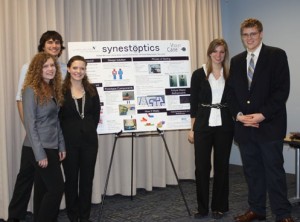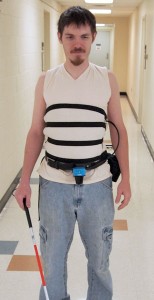
(left to right) Team members Emily Esko, Tom Lord, Lauren Gillmeister, Christine Kazlauskas, and Robert Morrison
The initial idea came to Tom Lord (BME 5th year) during a senior design course. It emanated, in fact, from a class exercise that asked all the students to think of innovative ways to improve upon the traditional white cane.
“Well,” Lord thought, “what if someone created a travel aid for the visually impaired that could locate objects several yards away and then transmit that information to the user?”
He shared his idea with several classmates, including Robert Morrison (BME, ECE 4th year), Emily Esko, Christine Kazlauskas, and Lauren Gillmeister. All quickly set to work, transforming the vision into reality.
“We took it very seriously,” said Lord.
What resulted became known as VIOLET (Vibrationally Informative Object Location Estimation and Transduction) Cane. Last month, the team presented VIOLET Cane at the 2012 ASME Undergraduate Design Project Competition in Rehabilitation and Assistive Devices. They placed first.
“We knew the competition there was going to be fierce,” said Morrison. “Honestly, we were happy to just be among the finalists. When we went on to win first place, it was just very exciting.”
One might also add, well deserved.
A prominent concern for visually impaired individuals is navigating their environment. With little or no visual input, they can have difficulty locating nearby objects and creating a mental map of their surroundings. VIOLET Cane seeks to change this.
VIOLET Cane is capable of detecting obstacles that are up to 13 feet away. When it detects such obstructions, it directly displays the location of those obstacles to the user through a grid of small vibration motors sewn into an undershirt.
The implications are clear.
“We have a device that could potentially help millions of people,” said Morrison.
Truly a team effort, Lord worked on the object detection system for VIOLET Cane and helped to test the undershirt. Morrison worked on the circuit board of VIOLET Cane and its design. He was also instrumental in securing funding and entering the team in various design competitions. Esko, Kazlauskas, and Gillmeister (BME ’12) determined the undershirt’s material (97 percent bamboo and 3 percent Lycra) and installed the small vibration motors.
Providing guidance and all forms of support along the way were Associate Professor of Biomedical Engineering Jennifer Kang-Mieler and Associate Professor of Biomedical Engineering Derek Kamper.
“It really helped to tap into their years of experience and know-how,” said Morrison, adding that his BME and ECE courses also helped him meet the challenges of product design and development. “We’re lucky we’re in the IIT environment.”
Lord expressed a similar sentiment.
“The BME department really engrained in us this idea of reviewing all the literature on a topic,” he said. “That proved very useful when we were attacking this project.”
Flush from their recent victory, Lord and Morrison are now working to commercialize VIOLET Cane. They are currently consulting with The Chicago Lighthouse, a non-profit agency that assists individuals who are visually impaired, to test and further refine the product.
“We do want to increase the maximum distance that VIOLET Cane can detect obstacles, the overall ergonomics, and VIOLET Cane’s user friendliness,” said Morrison. “Hopefully, people can start using this product soon.”

